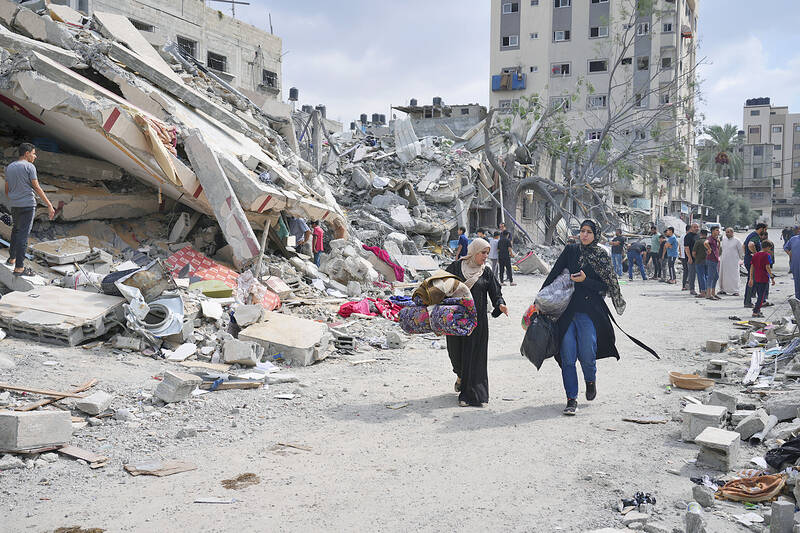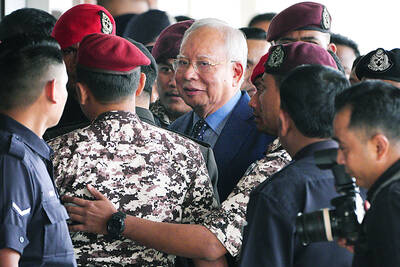A limited number of journalists in Gaza are trying to report on the war with Israel while facing the same problems as the besieged Palestinian population there — wondering where to live, where to get food and water, and how to stay safe.
The aftermath of Tuesday’s explosion that killed hundreds at a Gaza City hospital is the latest example of how that reality hinders the world’s ability to get a full picture of what is happening to the Palestinian population in Gaza.
Outside journalists have been unable to enter Gaza since the Hamas attack in Israel on Oct. 7. The sole entry point for journalists, Israel’s Erez crossing, was attacked in the rampage and remains closed. A handful of news organizations had maintained a regular presence with bureaus there, including The Associated Press (AP), the BBC, Reuters, Agence France-Presse (AFP) and al-Jazeera, with a network of stringers helping others.

Photo: AP
Israel’s order to Palestinians to evacuate the northern part of Gaza led journalists at AP and AFP to abandon bureaus in Gaza City and head south.
“Working in Gaza right now is extremely difficult and that’s in large part because our staff are both covering the story and worrying about their own safety and the safety of their families,” AP executive editor and senior vice president Julie Pace said.
AP staff stocked up on bottled water and other supplies before abandoning their Gaza City bureau, which replaced an office destroyed by Israeli bombs in 2021.
Even with power supplies limited, AP staff members have provided photos, video and other reporting each day since the war’s start, Pace said.
No such luck for a camera left behind on the bureau’s balcony that provided a live stream of the skyline; the generator likely ran out of fuel.
The nine AFP journalists in Gaza feel caught in a squeeze between wanting to work and also take care of their families, AFP global news director Phil Chetwynd said.
Managers are stressing the importance of safety first, he said.
“This is a population that over the years has been used to fairly extreme situations, but I think they would all say that this is on a much, much bigger scale,” Chetwynd said, referring to the previous four wars between Israel and Hamas.
At least 19 journalists have been killed since the start of the war, 15 of them in Gaza, the Committee to Protect Journalists (CPJ) said on Wednesday.
Already, more journalists have been killed in Gaza during the past two weeks than in the territory since 2001, CPJ’s Middle East and North Africa coordinator Sherif Mansour said.
On CNN, journalist Ibrahim Dahman reported on the journey to find safety that he took with his wife and two sons, ages 7 and 11. One son plaintively asked when they found a room: “They don’t strike hotels, right?”
“I feel intense fear,” Dahman said. “I am worried about myself, my wife and my children.”
AP photojournalist Adel Hana’s family fled to the central Gaza town of Deir al-Balah, below the evacuation line, to shelter in a cousin’s home near the local hospital, but a series of blasts rocked the building, killing at least seven family members and burying women and children in the rubble, he said.
“It doesn’t make sense,” Hana said. “We went to Deir al-Balah because we thought we would be safe.”
Marwan al-Ghoul, working for CBS News, was similarly heading south with his family in Gaza. When he came upon the aftermath of a bombing in a residential area, he got out to film scenes of bodies buried in rubble and crying children walking through the bombing site.
The need to bear witness, the journalists said, came after a week of intense focus on the attacks in Israel, where news media have been working freely. News organizations are conscious of the need to show that there is suffering on both sides.
Even with fewer news organizations operating in Gaza, there is a rich journalism tradition there, CBS News’ London bureau chief Andrew Roy said.
With advances in technology, many people are able to tote cameras to noteworthy scenes, he said.

The death of a former head of China’s one-child policy has been met not by tributes, but by castigation of the abandoned policy on social media this week. State media praised Peng Peiyun (彭珮雲), former head of China’s National Family Planning Commission from 1988 to 1998, as “an outstanding leader” in her work related to women and children. The reaction on Chinese social media to Peng’s death in Beijing on Sunday, just shy of her 96th birthday, was less positive. “Those children who were lost, naked, are waiting for you over there” in the afterlife, one person posted on China’s Sina Weibo platform. China’s

‘NO COUNTRY BUMPKIN’: The judge rejected arguments that former prime minister Najib Razak was an unwitting victim, saying Najib took steps to protect his position Imprisoned former Malaysian prime minister Najib Razak was yesterday convicted, following a corruption trial tied to multibillion-dollar looting of the 1Malaysia Development Berhad (1MDB) state investment fund. The nation’s high court found Najib, 72, guilty on four counts of abuse of power and 21 charges of money laundering related to more than US$700 million channeled into his personal bank accounts from the 1MDB fund. Najib denied any wrongdoing, and maintained the funds were a political donation from Saudi Arabia and that he had been misled by rogue financiers led by businessman Low Taek Jho. Low, thought to be the scandal’s mastermind, remains

‘POLITICAL LOYALTY’: The move breaks with decades of precedent among US administrations, which have tended to leave career ambassadors in their posts US President Donald Trump’s administration has ordered dozens of US ambassadors to step down, people familiar with the matter said, a precedent-breaking recall that would leave embassies abroad without US Senate-confirmed leadership. The envoys, career diplomats who were almost all named to their jobs under former US president Joe Biden, were told over the phone in the past few days they needed to depart in the next few weeks, the people said. They would not be fired, but finding new roles would be a challenge given that many are far along in their careers and opportunities for senior diplomats can

Australian Prime Minister Anthony Albanese yesterday announced plans for a national bravery award to recognize civilians and first responders who confronted “the worst of evil” during an anti-Semitic terror attack that left 15 dead and has cast a heavy shadow over the nation’s holiday season. Albanese said he plans to establish a special honors system for those who placed themselves in harm’s way to help during the attack on a beachside Hanukkah celebration, like Ahmed al-Ahmed, a Syrian-Australian Muslim who disarmed one of the assailants before being wounded himself. Sajid Akram, who was killed by police during the Dec. 14 attack, and